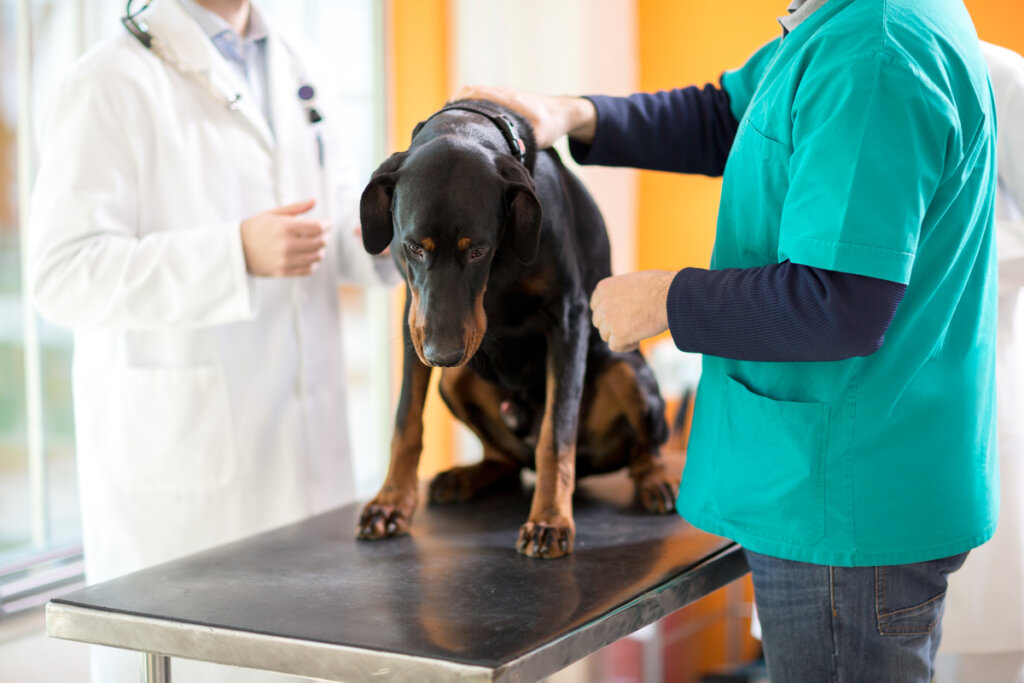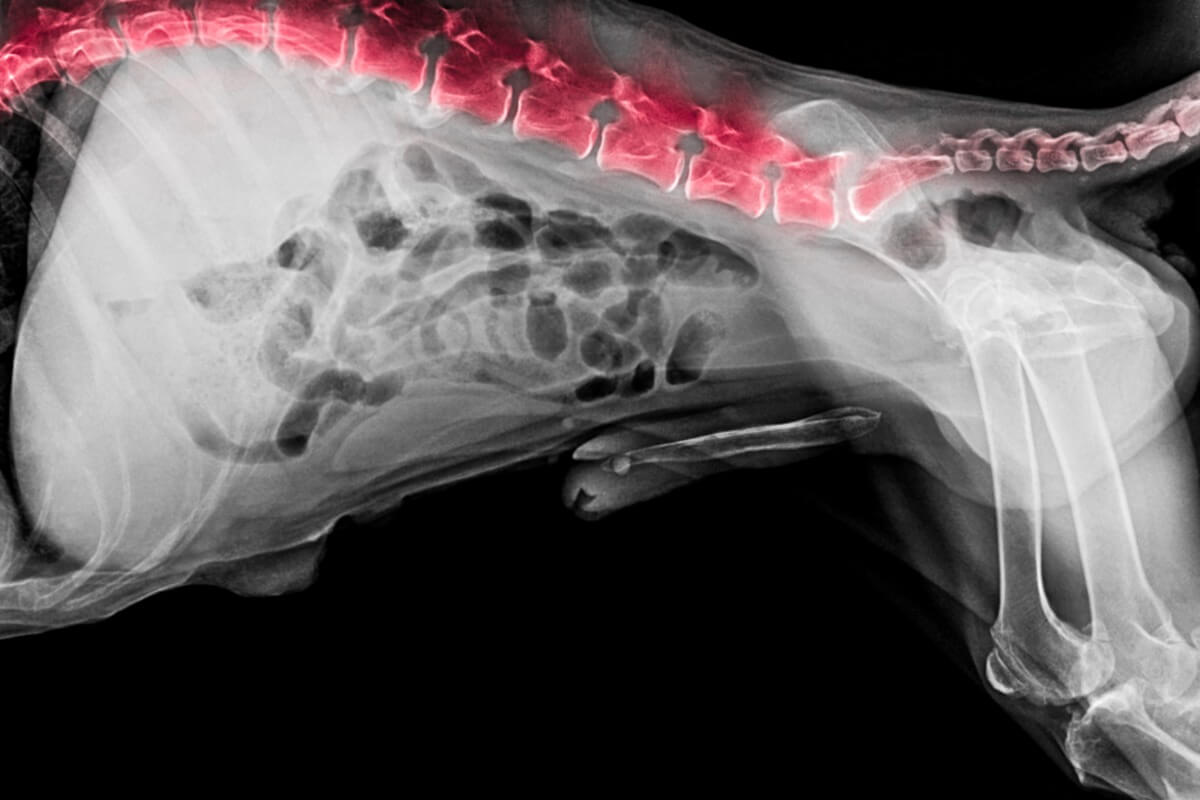Cauda Equina in Dogs: Causes and Treatments

If you notice that your dog can’t sit properly, suffers sudden mood swings, or shows signs of pain when you get up, you could be facing a case of cauda equina in dogs. It’s important to know the signs of this condition, especially if the dog is old and weak.
To help you better understand this ailment, in this article you’ll have all the basic information you need about the causes, symptoms, and treatment required.
What is cauda equina in dogs?
Also known as cauda equina or lumbosacral stenosis, cauda equina in dogs is a degenerative disease that affects the lumbosacral joint, i.e. where the hip ends and the tail of the dog begins (vertebrae L7-S1). As these bones degenerate, the spinal cord canal narrows and becomes compressed.
This condition causes severe pain in the area and movement difficulties in the canine. It’s also possible for a herniated disc to appear – secondary to the degenerative process -which greatly worsens the condition of the animal.

Causes of cauda equina in dogs
The most common cause is the passage of time itself, which naturally degenerates the bones of the animal. However, it can also appear for a variety of other reasons. We highlight the following:
- Vertebral dislocation
- Infection in the vertebrae
- Vertebral tumor
- Nerve tract tumor
- Traumatisms.
- Vertebral fracture
- Congenital abnormalities, such as spina bifida
- Spondylosis – any form of degeneration of the spine
- Hip dysplasia
- Herniation of the last intervertebral disc
Genetic predispositions
Although any dog can suffer from cauda equina, it appears more frequently in elderly and medium to large dogs. Some breeds are at higher risk for cauda equina, such as the German Shepherd, which is prone to hip problems in general. Other susceptible breeds are the Labrador, the Boxer, the Doberman, and the Golden Retriever.
Symptoms of the disease
The clearest signs of the disease are seen on the back third of the dog’s body. In cauda equina in dogs it’s easy to spot: when the animal doesn’t lift its leg to urinate, doesn’t wag its tail excessively, has difficulty walking or standing up, and shows a reduction in general activity. An altered and irritable mood is also common.
It’s characteristic to see how dogs with cauda equina drag the claws of the hind legs when walking.
Cauda equina also has several clinical signs that are detected at a visit to the veterinarian. Here are the most important ones:
- Lumbalgia or low back pain.
- Intermittent uni or bilateral lameness.
- Pain during walking
- Weakness or paralysis of the tail and pelvic area.
- Muscular atrophy of the posterior third of the body.
- Alteration in the reflexes of the hind legs.
- Urinary and fecal incontinence.
Diagnosis of cauda equina in dogs
Cauda equina in dogs has very general symptoms that are easily confused with the osteoarthritis that’s typical of old age. Furthermore, it doesn’t give distinctive signs – such as incontinence – until it’s already very advanced. At the symptomatic point, the dog suffers a lot of pain and the treatment isn’t as effective as in previous stages.
In the clinic, a series of basic tests are performed to determine the cause of the injury. The most common is an x-ray, with which the differential diagnosis is verified against other causes that could give similar symptoms, such as tumors or fractures. It may also be necessary to have a CT scan or MRI.
Treatment of the disease
The treatment to be administered to the dog will vary depending on the stage of progression of cauda equina and the incapacitation that it produces in the animal. In very severe cases only palliative treatment will be feasible, but, if diagnosed early, it’s possible to try to stop the progression or operate on the animal.
Palliative treatment of cauda equina in dogs
When the case is inoperable or function can’t be restored, a program to improve the dog’s quality of life will be implemented. Several strategies are used to achieve this:
- Pain control: This part is essential, because, as we have been saying, the pain suffered by the dog is intense and disabling.
- Support harnesses: These are used to manually raise the dog’s hindquarters and thus help them to walk better.
- Wheelchairs are recommended when there’s total immobility of the legs.
- Complementary treatments: Physiotherapy and acupuncture are some of the most commonly used.
Surgical treatment of cauda equina in dogs
When vets hope to restore mobility and quality of life in the dog – or when medication doesn’t work – surgically intervening in the area is a valid solution. The goal is to decompress the spinal cord.
The procedure chosen is called a dorsal laminectomy. To perform it, the spinal area L7-S1 is opened and the lamina, which is the back part of the vertebra that covers the spinal canal, is removed. This creates space for the spinal cord, freeing it from pressure.
The operation may vary depending on many factors, such as the presence of hernias or other injuries that require specific interventions.
Medical treatment of cauda equina in dogs
Since the surgical intervention is an invasive and expensive option, in cases that are still treatable, attempts are often made to control the progression of degeneration with drug therapy containing the following:
- Anti-inflammatories and analgesics: to alleviate the inflammatory and painful process.
- Chondroprotectors and B vitamins: these help to control the progression of primary or secondary osteoarthritis.
- Antibiotics: only used if the cauda equina is the result of an infectious process.
- Chemotherapy: if the origin is tumoral.
- Total or partial rest.

Finally, it’s important to emphasize is that early diagnosis is imperative to ensure the quality of life, if not recovery, from this disease. Although it may seem like osteoarthritis at first, you must visit the vet for confirmation. If you keep in your mind the thought of sparing your dog as much suffering as possible, prevention will be much more effective.
All cited sources were thoroughly reviewed by our team to ensure their quality, reliability, currency, and validity. The bibliography of this article was considered reliable and of academic or scientific accuracy.
- Martín, G. Surgery of the lumbosacral spine. Cauda equina syndrome and neoplasias. Canis et Felis (España).
- Morales Restrepo, A. (2020). Caso de estenosis degenerativa lumbosacra en hembra Pastor Alemán (Doctoral dissertation, Corporación Universitaria Lasallista).
- Mejía, E. C. S. (2008). Síndrome de cauda equina. Ortopedia, neurología y rehabilitación en pequeñas especies. Perros y gatos, 451.
- Orellana, R., & Antonio, R. (2003). Diagnóstico clínico y radiológico de síndrome de inestabilidad lumbosacra en perros pastor alemán adultos. Memoria de titulación.